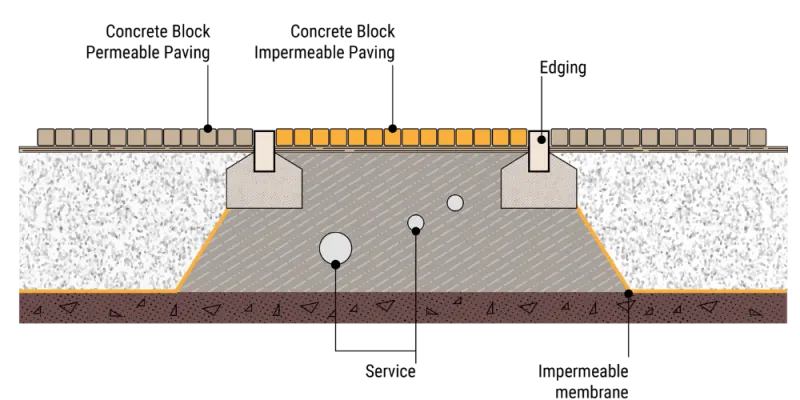Blog
When designing sustainable urban drainage systems (SuDs) and permeable block paving, you must consider the locations of services and utilities. Assets like these often require maintenance, which involves digging the ground to gain access.
In this industry, service cables combined with rainwater permeating through paving can raise some eyebrows. This blog should help answer the question of how to design a permeable pavement when service cables are present in your project.
Separating services and permeable paving is a good practice, as it will help give easy access to the services/utilities in the future. This is because the build-up of permeable pavements uses impermeable liners, base courses, aggregates, and textiles that can be easily damaged and hard to repair or reinstate when digging into the ground.
How to design a permeable pavement when there are service cables on your project
To allow service cables and permeable paving to be in the same area, we often design an impermeable strip of block paving over the top of the services and run adjacent or through a permeable area.
For this, the subbase materials of the impermeable strip of standard paving and permeable paving must be fully separated. Otherwise, you risk that the finer aggregates do not migrate into the voids of the porous subbase. This separation can be achieved using a geomembrane liner along the side of the adjacent permeable paving.

The strip of impermeable paving can be made into an aesthetic feature of the overall landscape and helps restrict the location of services. Often, the strip can be combined with other features, such as crossing points or pedestrian areas.
Marshalls has block paving families that include standard and permeable options, allowing designers to create a seamless design that incorporates both needs on a project.
If an impermeable strip interrupts the desired aesthetic of the landscape. The strip can be surfaced with permeable paving and permeable laying course but with an impermeable subbase. For this to work, you need to consider two things:
- Ensure that the "permeable" aggregates cannot mix and migrate with the impermeable subbase material
- Make sure that any run-off does not stagnate within the strip and will drain to the adjacent permeable area
You can learn more about hidden drainage solutions in the built environment on our blog.
Lifting and reinstating permeable paving
Regarding future access to services, you will need to be able to excavate an area. One of the benefits of block paving and permeable block paving is that you can install, lift and reinstate the existing blocks with no obvious signs of disturbance, especially when compared to other pavement materials, like tarmac.
The benefits of this are threefold:
- Minimising material wastage - Sourcing new materials has an environmental impact, with embodied carbon contributing massively to the overall carbon footprint of a development project. Lifting and reinstating individual pavers reduces the need to manufacture entire batches of paving stones.
- Cutting future costs - Complex excavation and resurfacing schemes can be costly, with labour and materials increasing as the scale of a project grows. By choosing permeable block paving, you can cut spending by minimising the quantity of new material needed.
- Reducing disruption - Digging up any public or commercial space will unavoidably cause some level of disruption, but contractors want to keep this to a minimum. Being able to lift and replace individual block pavers means you can cause as little disruption as possible by getting the job done quickly.
For more information, read our full guide on how to save time, costs, and carbon when hard landscaping
Future permeable pavement designs
There's no one-size-fits-all-all for this type of design consideration; it's necessary to adapt procedures based on each project.
That said, the design and engineering team at Marshalls has supported plenty of projects to help developers and designers overcome these common issues. We provide solutions allowing service corridors without impeding a permeable solution for a landscaped area.
For site-specific advice, contact our team, and we'll see how we can help: design.team@marshalls.co.uk











